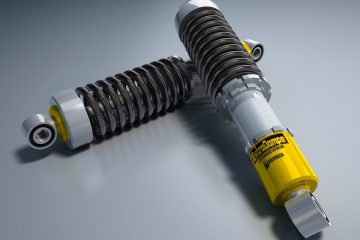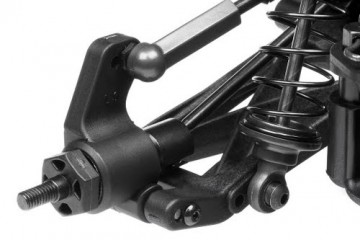Perhaps the simplest way to answer this question is that, the time for replacement comes when your shock absorbers are worn out, damaged or leaking. But how exactly do you spot these signs? Here are some tips to know if you need new shocks, or struts, as many people call it.
It is quite easy to spot if there is any leaking. You simply need to check for traces of oil or any wetness on the outer part of the shock or strut. A simple visual inspection can also reveal damage in terms of broken mounts, badly dented housing, etc. Often, the more difficult thing to spot is the wear on the shocks. It can be very subjective, as there may be instances when the original equipment shocks are not worn, damaged or leaking, but they are also not performing at par to normal expectations. In these cases, you can choose to upgrade your suspension to have a stronger, stiffer and more special shock. This can significantly improve handling as well as trailer towing, hauling overloads in your vehicle and other special uses.
To make things trickier, shocks or struts are not like filters or spark plugs that have standard replacements guides when they reach specific mileage intervals. Still, shock absorbers do get worn out and thus need replacement eventually. The trick is, there are not really any standard guidelines as to when they should be replaced. Some original equipment shocks can last after 30,000 to 40,000 miles. Some struts can last even after 50,000 to 60,000 miles. The exact replacement time is difficult to say because the damping qualities of shocks and struts experience gradual deterioration over time, and due to this gradual change, it is usually difficult to notice the decline in ride control. In most cases, when people notice that the shocks must be replaced, it has exceeded the optimal point in time for replacement.
One tip that you can use to check whether you need new struts is to reflect about how you have been using your vehicle. You can ask yourself several questions. Are you mostly driving on smooth traffic or rough roads? Do you pass through rough roads and bumps where your vehicle cannot stop to bounce excessively? Does your nose dip when you hit the brakes? Does the car body roll or sway too much when you are cornering or driving in crosswinds? Does the suspension bottom out when backing out the driveway or when you are hauling too many passengers or excess weight? If you answer yes to most or all of these questions, you should think of having more serious checks to see exactly what is wrong, or to what extent. A simple “bounce test” is still a good and valid way to check the dampening ability of your shocks and struts. If you find that the suspension continues to gyrate more than a couple of times after rocking and releasing the bumper or the body, it means that your shocks and struts are reaching their prime age and are in need of replacement.
Reasons for Replacements
Even if worn out shocks and struts are not direct causes of possible driving hazards, or even if you can bear the constant bouncing inside your vehicle, there are some studies that show that worn out shocks can increase the distance that it takes to put the vehicle to a full stop, especially on rough surfaces. Weak shocks or struts can result in increased body swaying as well as skidding on wet or slippery surfaces. Worn out shocks can also marginally increasing suspension wear, which in turn can affect tire wear.
Still, the most common reason for shock absorber replacement is to improve the overall ride quality. I don’t know about you, but I have endured 2 hours of bumpy ride o a van with defective shock absorbers, and it is not a pleasant experience at all. Replacing your worn out shocks can firm up your suspension and restore proper ride control.
Then again, if you are interested in even better performance, you can upgrade to gas-charged shocks or struts. These types are charged with high pressure nitrogen gas that can help minimize the foaming in the hydraulic fluid inside the shock. This can also lessen the “fade” on rough surfaces and can help the vehicle keep a better ride control even when cornering.
You can also resort to some “heavy-duty” replacement shocks and struts, as they have larger diameter pistons than stock. These types can also provide increased resistance, which gives the driver greater control. However, it may be a little too harsh for everyday driving. For this reason, some shocks have special valving or adjustable valving that allows some flexibility in the amount of resistance.
Still another option to consider if you are hauling extra cargo is to use overload or air-assist shocks. Overload shocks have a coil spring around them that increases the load carrying capacity of the suspension. These shocks also have the tendency to ride stiffer than standard replacement shocks. Moreover, these air-assist shocks have an adjustable air bladder that functions like a spring to allow you to carry more weight. With this type of shock, air can be added on a per-need basis when hauling extra weight.
About the replacement
You should note that shocks and struts are usually replaced in pairs. However, some there can be some exceptions especially if only one shock or strut is leaking or has suffered damage and you vehicle still has a very low mileage, and the other shock is still in tip-top shape.
The good thing is that shocks are a good do-it-yourself item almost all vehicles, because they are relatively easy to replace. On the other hand, some struts need a fair amount of suspension disassembly knowledge and skill. Part of it is also some wheel realignment. Thus, while you can replace your own shocks, it is advisable to have a professional mechanic replace your struts for you.
If you would like to purchase high quality car components online at discounted prices, please check out autopartsway.com.

